 Audio for slide 2 (mp3)
Audio for slide 2 (mp3)
Everyone has the right to go home at the end of the working day as fit and healthy as when they arrived. But a safe workplace doesn't just happen by accident. It takes a lot of effort from everyone involved - whether you're the owner, a staff member or a worker.
 Audio for slide 3 (mp3)
Audio for slide 3 (mp3)
In this unit, we'll look at the factors that help to keep a worksite safe. We'll start with the different types of procedures used to document 'approved' ways of carrying out a job. We'll also examine the laws and regulations that control safety in the workplace, the process of carrying out a risk assessment, and some of the procedures used to deal with emergencies.
 Audio for slide 4 (mp3)
Audio for slide 4 (mp3)
This unit is designed for people who work in the flooring technology sector, including on-site installers, warehouse store persons, showroom salespeople and administrative staff. Although the specific risks you face each day may be different from those faced by others in your organisation, the general processes used to minimise risks and keep the workplace safe are much the same. It all comes back to having a systematic approach to dealing with hazards and using approved 'low risk' techniques in all your activities.
 Audio for slide 6 (mp3)
Audio for slide 6 (mp3)
Safe work procedures can be written up in a variety of ways, and range from simple checklists through to formal documents. What they all have in common is that they provide workers with approved methods for carrying out tasks or using particular products.
 Audio for slide 7 (mp3)
Audio for slide 7 (mp3)
There are some procedures that you'll be personally involved in, such as safe work method statements. Others will come from product suppliers, such as material safety data sheets. And there will be others still that may not exist as stand-alone documents, but will form part of your company's 'Policies and Procedures' manual, like the requirement to wear personal protective equipment. In this section, we'll look at all of these types of procedures and discuss the effect they have on the way you do your job and the responsibilities you're given.
 Audio for slide 9 (mp3)
Audio for slide 9 (mp3)
A safe operating procedure (SOP) is a document that sets out the approved method of operating a particular machine or carrying out a task. In workplaces that have large static machines, SOPs are often put on a wall beside the machine to remind workers what the start-up and shut down procedures are, and what to do in the event of a malfunction or problem. But SOPs can also be written up for hand held tools and work processes, particularly when they involve the use of personal protective equipment or special techniques to avoid injuries.
 Audio for slide 10 (mp3)
Audio for slide 10 (mp3)
SOP layout Although there are various ways of developing an SOP, they generally follow the same layout. Click on the link below to see a sample SOP for a battery-powered circular saw.
 Audio for slide 11 (mp3)
Audio for slide 11 (mp3)
You'll notice that the SOP is divided into the following components: Activity description - defining the task. Potential hazards and safety controls - listing the main hazards and how to deal with them (see Section 3 for more details on what a 'hazard' is)'. Pre-start checks - providing a set of safety checks to work through before turning on the equipment. Operational procedure - setting out the main steps involved in using the equipment safely.
 Audio for slide 13 (mp3)
Audio for slide 13 (mp3)
A safe work method statement (SWMS) is a formal document that lists all the tasks involved in completing a job and describes how the hazards will be controlled. On building sites they are mandatory for 'high risk construction work'. However, on some sites all contractors are asked to complete a SWMS before they start work - including flooring installers.
 Audio for slide 14 (mp3)
Audio for slide 14 (mp3)
In some Australian states, a job safety analysis (JSA) is often used to document the hazards and control measures involved in carrying out a job. This is similar in layout to the SWMS and is sometimes used interchangeably. Nonetheless, even in the states where JSAs are common, it is now a legal requirement to develop a SWMS for high risk work.
 Audio for slide 15 (mp3)
Audio for slide 15 (mp3)
Because SWMSs are legal documents that can end up being tendered in court proceedings, they need to be signed off by everyone directly involved. This helps the contractor to prove that each worker had understood what their responsibilities were before they started a job and had agreed to follow all of its safety provisions.
 Audio for slide 16 (mp3)
Audio for slide 16 (mp3)
The law also says that everyone who uses the SWMS needs to be 'consulted' while the document is being developed. This gives workers the chance to express their views on the risks involved in doing particular tasks and the controls put in place to reduce the risks. We'll talk more about the consultation process in the next section of this unit.
 Audio for slide 17 (mp3)
Audio for slide 17 (mp3)
Click on the link below to see a sample SWMS. This is based on a template developed by Safe Work Australia and published in the Construction Work Code of Practice. Sample SWMS You can download the full code of practice from the Supporting Resources section of this unit. There are various other templates for SWMSs on the web, produced by organisations such as WorkCover, industry associations and private companies. To find them, just type 'Safe Work Method Statement' into your search engine and follow the links.
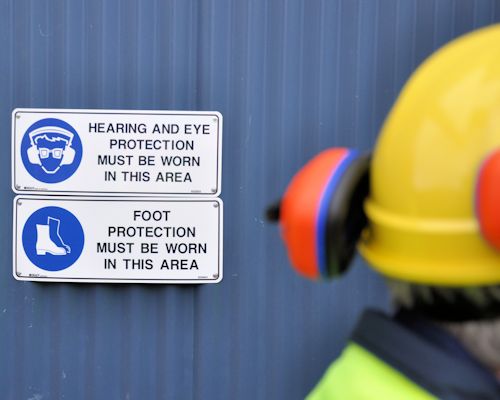 Audio for slide 19 (mp3)
Audio for slide 19 (mp3)
Personal protective equipment (PPE) refers to the safety gear you wear to protect particular parts of your body. Some items, such as safety boots, are often compulsory for all people on large building sites.
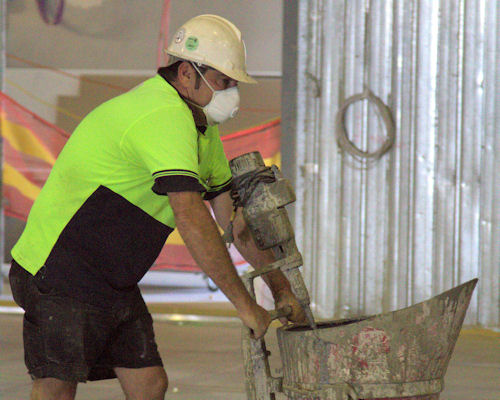 Audio for slide 20 (mp3)
Audio for slide 20 (mp3)
Other items are generally specified for particular jobs, such as dust masks when mixing levelling compounds and knee pads when working on your knees. Your company will have set procedures for the different items of PPE that you're required to wear. These will be specified in the safe operating procedures or safe work method statements that apply to the work you're doing.
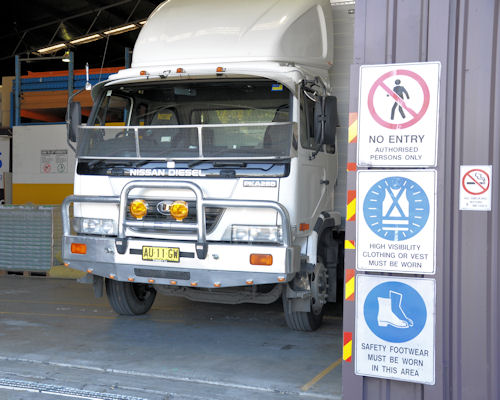 Audio for slide 21 (mp3)
Audio for slide 21 (mp3)
On large sites and in warehouses and factories, there might also be signs up on the wall or at entranceways to alert people to the PPE items required in those areas. It's important to remember that if the company has made it a requirement to wear PPE, you have a legal obligation to do so. This means that if you get hurt and you're not wearing the necessary safety gear, you might end up being in trouble with the law, quite apart from any injuries you suffer. Common symbols Below are the main symbols you're likely to see on building sites and in suppliers' warehouses.
 Audio for slide 23 (mp3)
Audio for slide 23 (mp3)
Every manufacturer of a hazardous substance or product is required to produce a material safety data sheet (MSDS) for it. The purpose of the MSDS is to tell people how to use the product safely, what the long-term health effects are, and how to deal with environmental care issues, such as spillages and waste disposal.
 Audio for slide 24 (mp3)
Audio for slide 24 (mp3)
You shouldn't have any trouble finding an MSDS for a product, because your own workplace is required to have an MSDS on file for every hazardous product kept on-site. These are meant to be in an accessible place where workers can go to them at any time. The link below will take you to the MSDS for Ardex K15 smoothing compound. Ardex K15 MSDS (pages 1 and 2 of a 14 page document) You can access the original document from the Ardex Australia website.
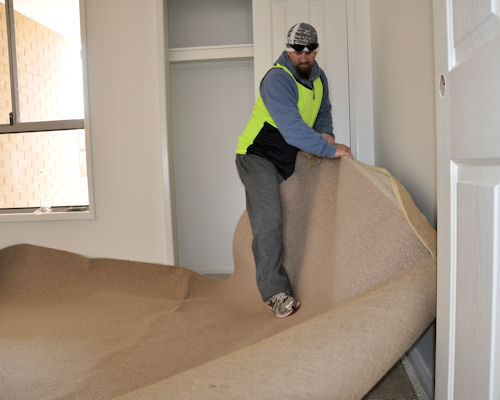 Audio for slide 26 (mp3)
Audio for slide 26 (mp3)
Whenever you're doing work that puts a strain on your muscles or joints, you need to think about manual handling techniques and body postures. This includes the methods you use to lift and carry materials, place floor coverings in position and work on your hands and knees.
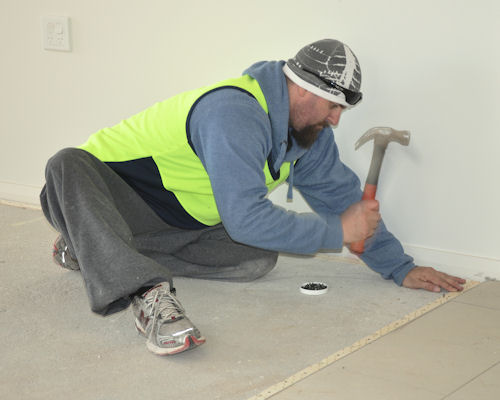 Audio for slide 27 (mp3)
Audio for slide 27 (mp3)
It's worth keeping in mind that joint and muscle problems are much more likely to be caused by gradual wear and tear on your body through bad work practices than from a one-off accident. Flooring installers are particularly prone to injuries and long-term medical conditions in two parts of their bodies - their back and their knees. Because knees can cause so much trouble for floor layers, we'll look at that separately in the next lesson. So for now, let's talk about back care.
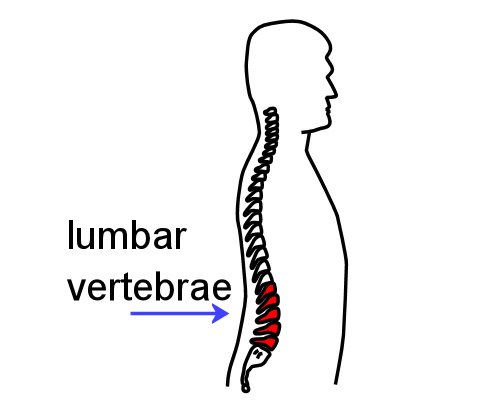 Audio for slide 28 (mp3)
Audio for slide 28 (mp3)
Looking after your back Back injury is sometimes caused by lifting a load that's too heavy, but it can also occur from pushing, pulling, or twisting while your back is under strain. The real problem area for most people is the lumbar region. This is the area that allows you to bend forwards, backwards, from side to side and to twist around. To understand why the lumbar region is prone to injury, you need to know how it's constructed.
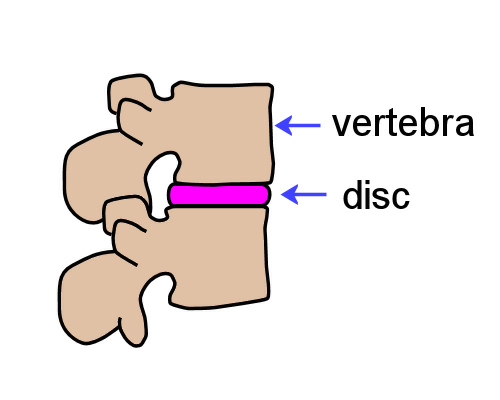 Audio for slide 29 (mp3)
Audio for slide 29 (mp3)
The spine is made up of a set of vertebrae stacked one on top of another. Between the vertebrae are discs, which act like shock absorbers - compressing when the spine is bearing a load, and springing back again when the load is taken away.
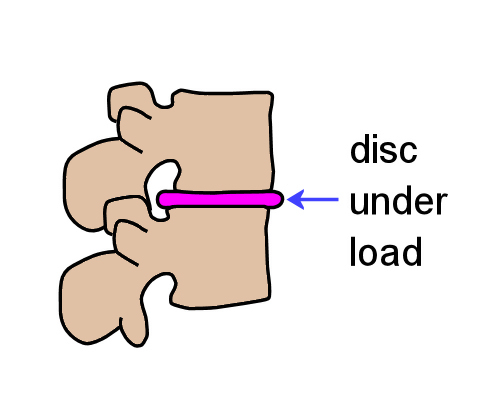 Audio for slide 30 (mp3)
Audio for slide 30 (mp3)
However, the discs can only cope with maximum pressure when your pelvis is level and your spine is in a balanced position above it. So when you bend or twist while holding a load, you're putting uneven stresses on the discs in addition to the extra weight they have to bear.
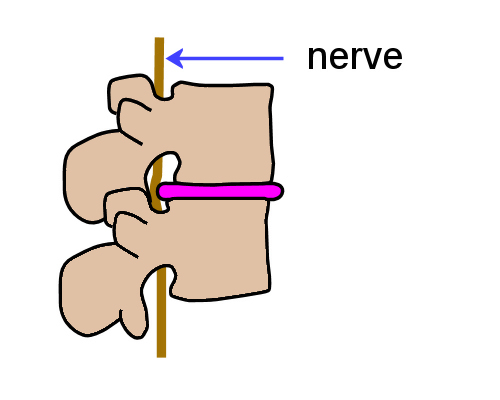 Audio for slide 31 (mp3)
Audio for slide 31 (mp3)
Many injuries result in fatigued muscles going into spasm, causing back pain and difficulty in standing up straight. In serious cases, a bulging disc can rupture and come into contact with a nerve in the spinal cord. Some people call this a 'slipped disc'.
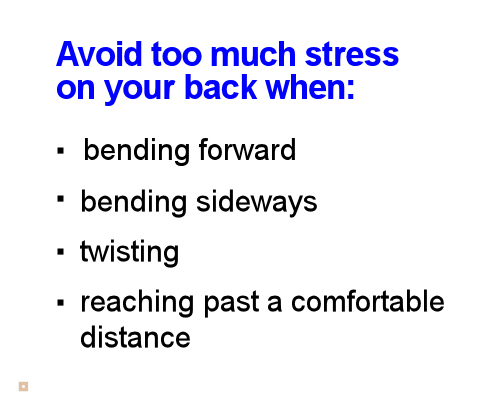 Audio for slide 32 (mp3)
Audio for slide 32 (mp3)
So how does this affect the way you should work? The general rule is - try to avoid putting too much stress on your back when: bending forward bending sideways twisting reaching past a comfortable distance.
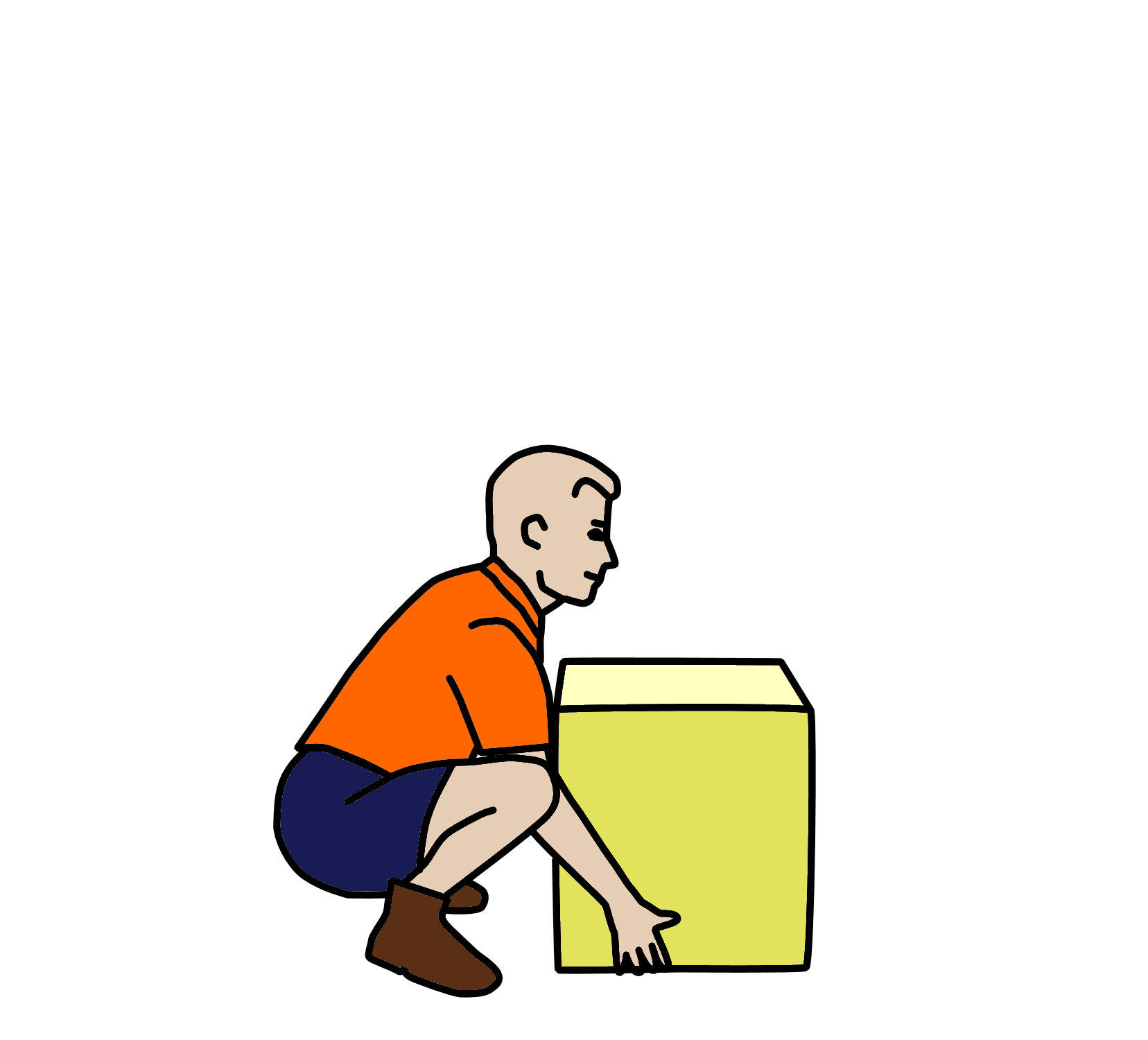 Audio for slide 33 (mp3)
Audio for slide 33 (mp3)
Here are the main steps you should follow when you need to lift and carry a large, heavy or awkward object. Size up the load and decide whether you'll need help to lift or move it. Check the path you will be taking to make sure there are no obstacles in the way. Place your feet firmly on the ground and put your body in a balanced position. Bend your knees to get down to the load, and keep your back as straight as possible.
 Audio for slide 34 (mp3)
Audio for slide 34 (mp3)
- Use your legs to do the lifting as you stand up straight.
- Keep the load close to your body while you're carrying it.
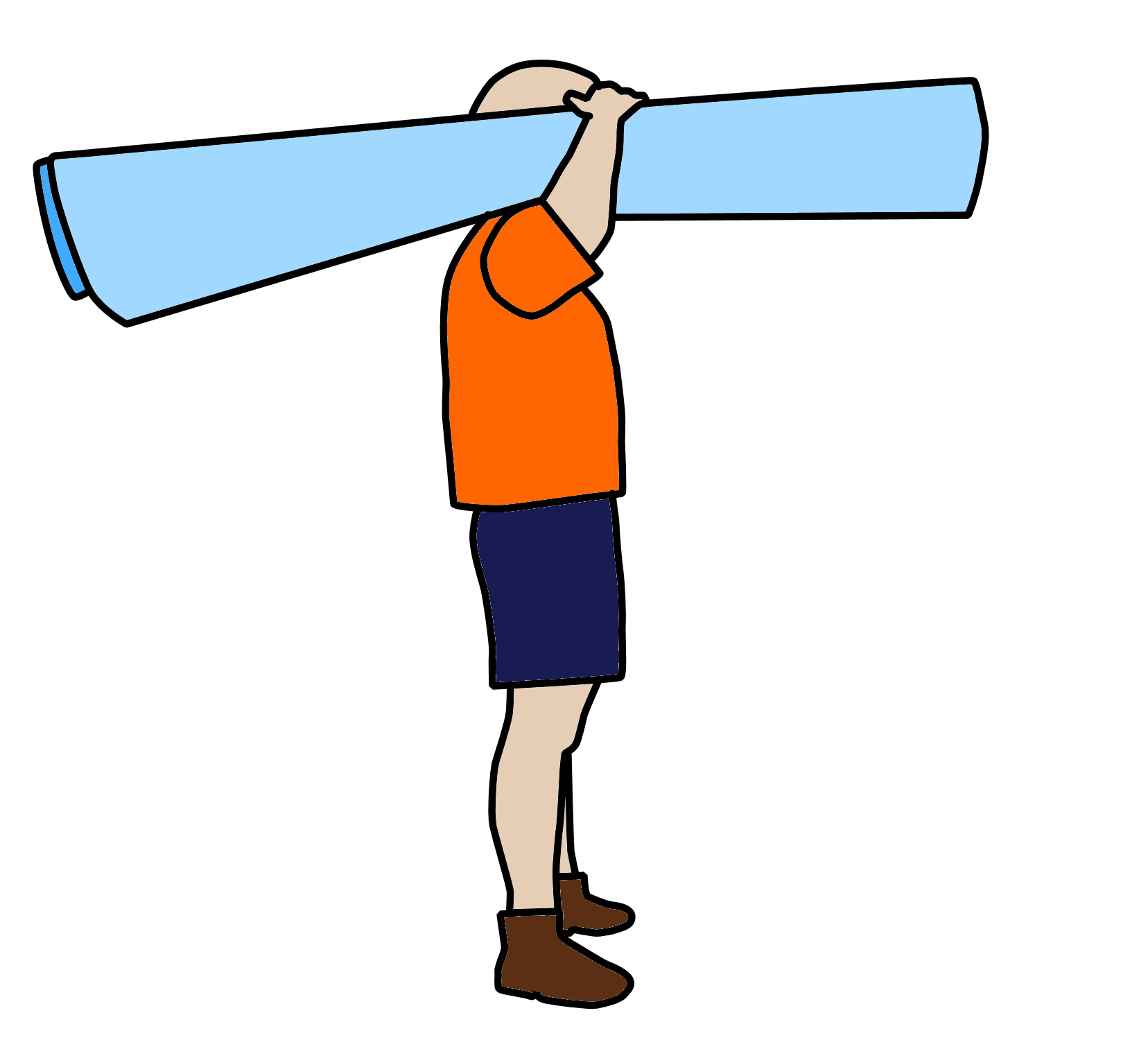 Audio for slide 35 (mp3)
Audio for slide 35 (mp3)
Carrying a roll When you're lifting and carrying a roll of carpet, the basic principles are all the same - keep your back as straight as possible and your body in a balanced position. However, this time you should support the middle of the roll on your shoulder.
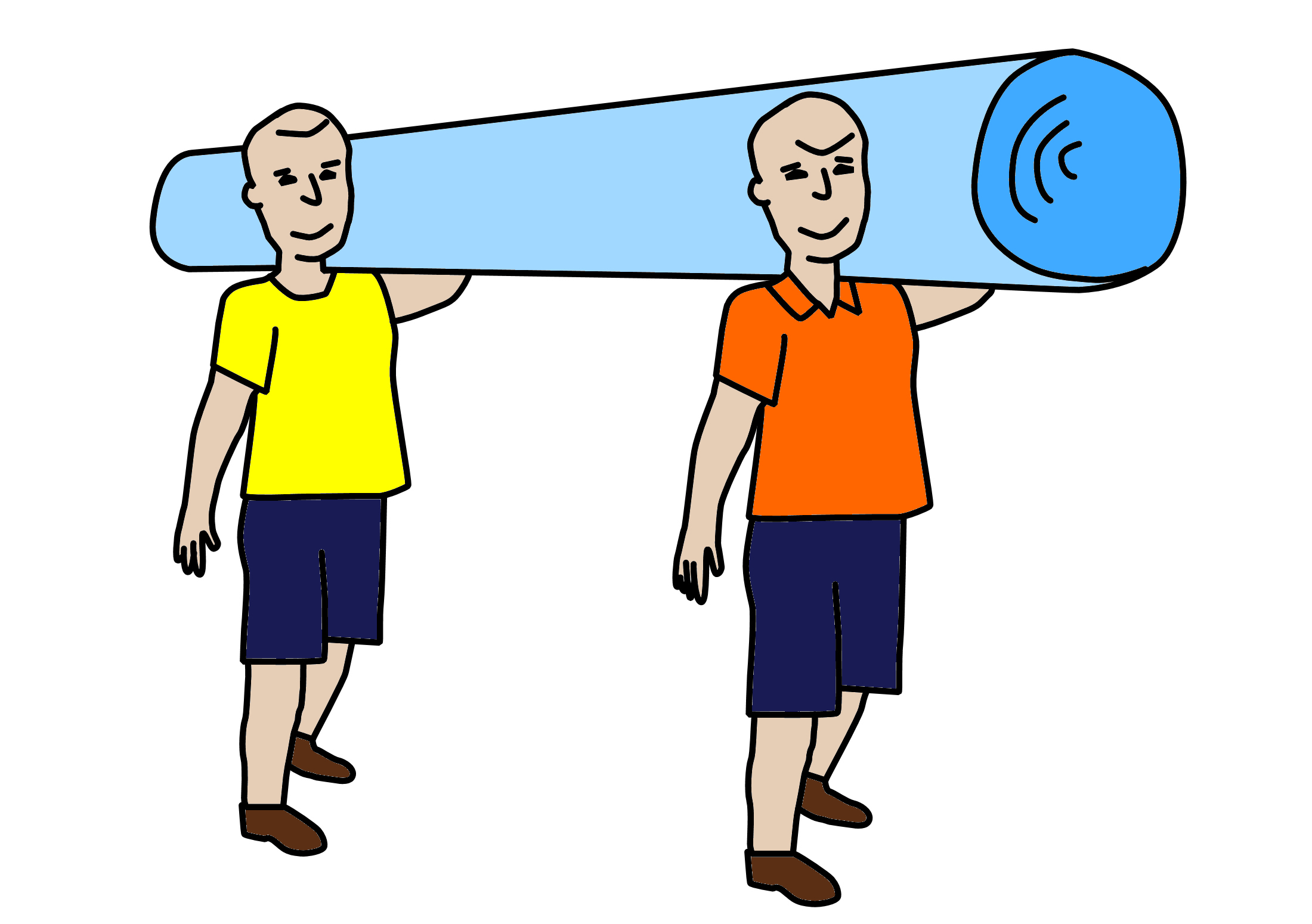 Audio for slide 36 (mp3)
Audio for slide 36 (mp3)
If the roll is long or heavy, or if you need to manoeuvre it around awkward hallways or up stairs, it's best to get an offsider to help. But remember, if you're lifting and carrying carpet with an offsider, good communication is vitally important. You both need to work in unison and know exactly what the other person is about to do.
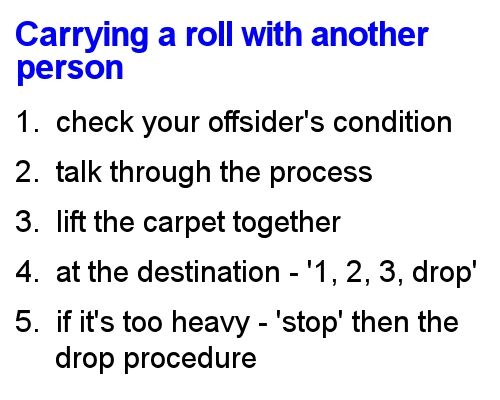 Audio for slide 37 (mp3)
Audio for slide 37 (mp3)
Here are some hints on how to carry a roll of carpet with another person. Check that your offsider doesn't have any back or muscle injuries that might affect the work you're about to do. Talk through the process. State which side you are going to stand on, what path you'll take, where you're going to put it, and how you'll deal with any obstacles or corners on the way. Lift the carpet together. You might even want to lift on the count of three: '1, 2, 3, lift.' When you get to the destination, count: '1, 2, 3, drop', and both tilt your shoulders at the same time to let the carpet roll off and drop to the floor. If at any time you're not comfortable or the carpet is too heavy, call out 'Stop' and do the '1, 2, 3, drop' procedure together. Don't let go of your end unexpectedly, because this will jar the other person.
 Audio for slide 39 (mp3)
Audio for slide 39 (mp3)
It's a basic fact that flooring installation occurs at floor level, so you're going to spend a lot of time on your knees. The problem is that although knees are very good at carrying the body's weight when you're upright, they not designed to bear a lot of weight when you're moving around in a kneeling position.
 Audio for slide 40 (mp3)
Audio for slide 40 (mp3)
One of the medical conditions that a floor layer can develop is kneecap bursitis. This is caused by repeated pressure on the kneecap, which inflames a small sac called the pre-patella bursa. There are several other bursas in the knee, including the infra-patella bursa, that can also become inflamed if you spend a lot of time working on your knees. When a bursa is operating normally, it holds a few drops of fluid which lubricate the movement between the bones and tendons. But if the joint is put under too much pressure or strain, it tends to collect excess fluid and swells up, sometimes quite dramatically.
 Audio for slide 41 (mp3)
Audio for slide 41 (mp3)
Bursitis makes the knee very painful to move. In serious cases it can also become infected, which may require surgical cleaning. Long term abuse of your knees eventually wears out the surfaces of the joints between the bones, causing arthritis. The simplest treatment for a mild case of bursitis is to rest your knee and put ice on it. In more serious cases the bursa may need to be drained with a needle. If the pain and swelling become chronic, the bursa might have to be removed through surgery.
 Audio for slide 42 (mp3)
Audio for slide 42 (mp3)
The easiest way to avoid knee problems is to take care of them while you're working. You can do this by wearing knee pads whenever you're working on your knees, and giving your legs a break by periodically standing up, stretching and walking around.
 Audio for slide 43 (mp3)
Audio for slide 43 (mp3)
Knee pads There are lots of different knee pads on the market, ranging from cheap mass-produced products to high quality custom-fitted models. Don't wait until you're nursing an injury before you start to wear knee pads! You should put them on whenever you're going to be working on your knees. It goes without saying that if you look after your knees while they're still healthy, you'll be able to keep them that way for many years.
 Audio for slide 44 (mp3)
Audio for slide 44 (mp3)
Stretches and exercises Keeping the muscles around your knees strong and flexible will help you to reduce the chance of an injury. There are lots of exercises you can do to strengthen your muscles and improve your flexibility. If you play competitive sports on weekends or go to the gym or a fitness class regularly, you may already being doing some of them. Have a look at the examples shown on the Just for fun page for this section. These simple exercises will help to get you started.
 Audio for slide 47 (mp3)
Audio for slide 47 (mp3)
Most companies spend a lot of time and money keeping their Work Health and Safety (WHS) system up-to-date, so that it stays compliant with changing legislation, codes of practice and insurance company requirements. But the bottom line can always be summed up in the basic question: Is the system making the workplace safer?
 Audio for slide 48 (mp3)
Audio for slide 48 (mp3)
If the answer is 'Yes', then your safety system is working. Not that this means you can relax and take it for granted. An effective system is only effective while everyone continues to apply its policies to their daily activities.
 Audio for slide 49 (mp3)
Audio for slide 49 (mp3)
If the answer is 'No', then you've got a problem on your hands. No-one likes filling out forms if they think it's pointless. And people soon lose the motivation to follow strict procedures if they don't see any benefit in it.
 Audio for slide 50 (mp3)
Audio for slide 50 (mp3)
In this section, we'll look at the legislation that underlies safety in the workplace, and the administrative system that turns these laws into workplace practices. We'll also discuss the role of the new 'model' Work Health and Safety Act (2011) that has replaced the old Occupational Health and Safety (OHS) Act in most states and territories, and the continuing process of 'harmonisation' occurring between them.
 Audio for slide 52 (mp3)
Audio for slide 52 (mp3)
All states and territories in Australia have laws that cover workplace safety. Although the laws have always been very similar, until recently they were developed separately by each jurisdiction and given titles like the Occupational Health and Safety Act or Workplace Health and Safety Act. Each of these Acts has a set of legally-binding Regulations, which expands on particular aspects of the Act and provides details on how it should be implemented.
 Audio for slide 53 (mp3)
Audio for slide 53 (mp3)
Over the last couple of years, the states and territories have been working towards 'harmonising' their laws - that is, aligning them to a set of new 'model' laws developed by the Federal Government. Along with this new Work Health and Safety Act are model Regulations and Codes of Practice. These documents have been developed by Safe Work Australia, the new government body created to oversee the harmonisation process. It was hoped that by the end of 2012 all states and territories would have adopted the new Act and Regulations. However, it's turned out that Victoria and Western Australia have decided to remain with their existing laws, for the time being at least, while they consider how they will proceed.
 Audio for slide 54 (mp3)
Audio for slide 54 (mp3)
Changes in the WHS Act and Regulations In practice, the new Act and Regulations are much the same as the previous state-based laws. The purpose of these national laws was not to make a whole lot of changes, but to bring all the little differences between the jurisdictions into line. This is especially helpful for people who work interstate and companies that have a national coverage.
 Audio for slide 55 (mp3)
Audio for slide 55 (mp3)
One obvious difference between the new WHS Act and the old state-based Acts is the terminology used to describe 'employers' and 'employees'. Because there are so many ways of working under the direction of a 'boss', the person in charge of an operation is no longer called the 'employer'. They are now a 'person conducting a business or undertaking', or PCBU. The term 'employee' is also no longer used, and anyone who carries out work for a PCBU is now simply called a worker. This change was needed so it could include volunteers, students, subcontractors and anyone else who works for another party, whether they're technically 'employed' by them or not.
 Audio for slide 56 (mp3)
Audio for slide 56 (mp3)
Which Act applies to your state or territory? Write down its full title, including the date it was passed by the state or territory government. If you're not sure which Act is currently in place, click on the link below to see the latest update on the harmonisation process. Safe Work Australia - Jurisdictional progress on WHS laws Click on the link below to see a list of 'model' Codes of Practice. Safe Work Australia - model Codes of Practice Which of these codes relate to the sort of work you do? Write down their titles. Follow the links to the codes that interest you most and have a look at the work practices they describe.
 Audio for slide 58 (mp3)
Audio for slide 58 (mp3)
In general, the rights and responsibilities of all people in the workplace are defined in the WHS Act or OHS Act that applies to that state or territory, and the Regulations that go with the Act. Whichever laws are in place, they all say that everyone has a duty of care to ensure that their actions don't endanger others. Everyone is also required to report any hazards they notice in the workplace, so that steps can be taken to minimise the risk of an injury or illness occurring. As well as these general responsibilities there are specific responsibilities relating to each level of employment, as shown below.
 Audio for slide 59 (mp3)
Audio for slide 59 (mp3)
Specific responsibilities Directors are responsible for: ensuring that the company's WHS policies are effective in keeping the workplace safe ensuring that the company's activities comply with all WHS legislation.
 Audio for slide 60 (mp3)
Audio for slide 60 (mp3)
Managers are responsible for: developing and implementing safe work policies and procedures consulting with the workforce on WHS issues distributing all relevant information to employees.
 Audio for slide 61 (mp3)
Audio for slide 61 (mp3)
Supervisors are responsible for: supervising the performance of workers ensuring that workers are properly trained carrying out regular safety inspections correcting unsafe work practices and disciplining workers who disregard WHS policies.
 Audio for slide 62 (mp3)
Audio for slide 62 (mp3)
Workers are responsible for: taking care of the health and safety of themselves and others who may be affected by their actions following safe operating procedures and other safety directions from management reporting hazards or unsafe work practices to their supervisor reporting any injuries to their supervisor cooperating in health and safety programs.
 Audio for slide 63 (mp3)
Audio for slide 63 (mp3)
Rights The laws also give workers certain rights. For example, workers have the right to raise genuine safety issues with their supervisor or manager and have their concerns taken seriously. They're also protected from discrimination if they report a hazard or unsafe work practice. Safety officers and WHS committee members are also protected from discrimination as they carry out the duties relating to that position, such as doing site inspections or investigating the causes of accidents.
 Audio for slide 65 (mp3)
Audio for slide 65 (mp3)
Experienced workers generally have a very good idea of where the hazards are in the work they do. They're also likely to feel a lot more inclined to put new work methods into practice if they've had a hand in developing them. This is why consultation between managers and workers is essential for any WHS system to work properly. It's also a requirement under the law.
 Audio for slide 66 (mp3)
Audio for slide 66 (mp3)
Managers are required to consult with their workers whenever: issues arise that might affect the health or safety of workers risk assessments are undertaken new measures are put in place to control risks new work or safety procedures are introduced decisions are made about workers' facilities changes are made to the workplace, equipment or systems of work that may affect safety and welfare.
 Audio for slide 67 (mp3)
Audio for slide 67 (mp3)
Methods for consulting with employees Depending on the size of the workplace, there are various ways a business can consult with its workers. Large organisations generally have a safety committee that meets regularly and has members representing management and the workforce. Formal minutes are taken at each meeting, and particular members are given duties to carry out in the workplace, which are reported back to the committee when completed.
 Audio for slide 68 (mp3)
Audio for slide 68 (mp3)
Companies also conduct regular toolbox meetings with workers. These are generally organised by the supervisor in each section of the workplace, and minutes are taken of the points discussed. A toolbox meeting allows workers to raise safety concerns or report hazards. It also lets the supervisor pass on WHS information, or discuss new procedures that are being introduced.
 Audio for slide 69 (mp3)
Audio for slide 69 (mp3)
Regardless of the size of the workforce, every business is required to have arrangements in place to allow the free flow of information between management and workers. In the case of a very small business, this may simply involve you speaking directly to your boss. But whatever the arrangements are, documentary records must be kept to show that consultation is occurring properly, and workers views are being taken into account when the boss makes decisions about workplace health and safety.
 Audio for slide 71 (mp3)
Audio for slide 71 (mp3)
If your company's WHS system has turned into a big paper shuffling exercise, then it's not doing the job it's supposed to. A good system doesn't need a lot of fancy documents, it just needs a user-friendly set of policies, procedures, and checklists - to help encourage everyone to keep the records up-to-date, and most importantly, put the safety procedures into action.
 Audio for slide 72 (mp3)
Audio for slide 72 (mp3)
This is where a WHS management system comes into play. The WHS management system allows a company to integrate its safety policies and procedures into all of its activities, and record the effort it is making to handle safety issues. This not only provides evidence that the company is complying with WorkCover requirements, it also gives the directors a sound picture of how well everything is working. Click on the links below to see the names and descriptions of some typical documents that a company might keep in its WHS management system.
 Audio for slide 73 (mp3)
Audio for slide 73 (mp3)
As you can see, there's a wide range of documents that might be included in a company's WHS system. If the business you work for is very small, it may not use all of these documents, or it may combine some of them so that the one document has several functions. Which of these documents do you use in your workplace? Are there any other safety-related documents you use that are not listed above? What are they, and what is their purpose?
 Audio for slide 85 (mp3)
Audio for slide 85 (mp3)
Risk management is all about identifying hazards and minimising the risk of them causing an illness or injury. The most effective way to identify hazards and decide on what action should be taken is to carry out a risk assessment.
 Audio for slide 86 (mp3)
Audio for slide 86 (mp3)
There are three basic steps involved in carrying out a risk assessment: identify the hazards assess the risks control the risks. In this section, we'll look in detail at the three-step process of carrying out a risk assessment.
 Audio for slide 88 (mp3)
Audio for slide 88 (mp3)
A hazard is anything that might harm the health or safety of someone. Depending on where you're working, it could include airborne dust, sharp blades, obstacles, electrical currents, vehicles, noise, chemical fumes, or anything else that might cause an injury or illness. The most obvious way to identify hazards is to go out into the workplace and look for them. But there are other methods of finding potential hazards.
 Audio for slide 89 (mp3)
Audio for slide 89 (mp3)
Here are the most common methods used to identify hazards: carry out a workplace inspection talk to other workers check injury records check the 'safety hazard log book' get expert advice from an industry consultant review the code of practice.
 Audio for slide 91 (mp3)
Audio for slide 91 (mp3)
Once the hazards have been identified, they can be given a risk rating, depending on how urgently they need to be addressed. The risk matrix shown below has been designed by WorkCover to rate the likelihood of an accident occurring, and the seriousness of the harm that might result. This allows a priority rating to be put against each of the hazards identified, so that the most serious ones can be dealt with first.
 Audio for slide 92 (mp3)
Audio for slide 92 (mp3)
Let's take a couple of examples to see how you can use the risk matrix to rate the seriousness of a hazard and decide on the best course of action to take. 1. Hazard in the warehouse There is a large pothole near the entranceway to the warehouse. The forklift truck could tilt to one side if its tyre went into the hole, which would destabilise the load and may even cause the forklift to fall sideways. This could happen any time, and if it did, might result in someone being seriously injured and cause major damage to the forklift.
 Audio for slide 93 (mp3)
Audio for slide 93 (mp3)
When you go to the risk matrix, you would choose 'likely' (column 1) and 'high level of harm' (row 1). This is a risk rating of 1 - the highest level - so the problem needs to be dealt with urgently. In practice, you would immediately isolate the area with barrier boards or witches hats and then get the pot hole filled in as soon as possible.
 Audio for slide 94 (mp3)
Audio for slide 94 (mp3)
2. Hazard out on-site An installer needs to apply a levelling compound to a concrete subfloor. He knows that when the cement-based compound gets on his hands it causes his skin to dry out, and repeated contact results in dermatitis. The last time he developed dermatitis, he had to go to the doctor and get a prescription for a medicated hand cream.
 Audio for slide 95 (mp3)
Audio for slide 95 (mp3)
Although he uses tools to mix and apply the patching compound, there is still a 'moderate' chance (column 2) he could get it on his skin, which would result in a 'low level of harm' (row 3). Therefore, the risk rating is 3. In practice, the installer would wear a pair of gloves while he's mixing and applying a patching compound, especially if he needs to push any of the wet mix into the holes or cracks by hand.
 Audio for slide 97 (mp3)
Audio for slide 97 (mp3)
Most hazards can be controlled in a variety of ways. Obviously, the best control would be to eliminate it completely. But that isn't always possible. So the most practical process for deciding on how to address a hazard is to find the best solution from the 'hierarchy of controls'. It's called a hierarchy because you start at the top of the list - removing the hazard from the workplace - and work progressively down to the bottom - accepting that the hazard must remain and providing personal protective equipment.
 Audio for slide 98 (mp3)
Audio for slide 98 (mp3)
Hierarchy of controls Below is the order you should work through to find the control that is most appropriate. In many cases, you may find that more than one control is necessary. For example, training might be used as one of the controls with most hazards. Eliminate the risk, such as through removing the dangerous machine or situation, or changing the way the job is done. Substitute the hazardous machine or process with a safer one. Engineer a solution to control the risk, such as with guards, dust extraction systems or other mechanical aid. Isolate the machine, process or area to keep workers clear of the hazard. Train workers to avoid the risk, such as through the use of Safe Operating Procedures. Issue personal protective equipment to workers, such as hearing protection, eye protection or safety boots.
 Audio for slide 102 (mp3)
Audio for slide 102 (mp3)
Emergencies are situations that are dangerous to life, property or the environment. They may arise from a fire, explosion, accident, or some other incident that occurs without warning. By their very nature, emergencies are unexpected and catch people by surprise. But if you've already put procedures in place to cope with the incident, you'll be able to take control of the situation in an organised way.
 Audio for slide 103 (mp3)
Audio for slide 103 (mp3)
In this section we'll discuss various types of emergencies that you may encounter, either on-site at a client's property or in your own workplace. We'll also describe the general procedure for carrying out an emergency evacuation.
 Audio for slide 105 (mp3)
Audio for slide 105 (mp3)
Most workplaces and large building sites have an evacuation procedure in place, with a designated Assembly Area for people to go to. The evacuation procedure and site map are often posted up in various places around the worksite. But if you're at a domestic building site or in a client's home, there probably won't be a formal procedure for carrying out an evacuation. In these cases, all people on-site should assemble in an open area clear of the building so that everyone can be easily accounted for.
 Audio for slide 106 (mp3)
Audio for slide 106 (mp3)
General emergency evacuation procedure Where there is a site procedure for emergency evacuations, it's normal practice for everyone who comes on-site to be 'inducted' when they arrive for the first time. At the induction session you're given information about the site's safety policies and procedures, including what to do in the event of an emergency. The procedure shown below is a general guide on how to respond to an emergency if there is no formal procedure in place.
 Audio for slide 107 (mp3)
Audio for slide 107 (mp3)
Raising the alarm If you're the first person to know about the emergency: Notify your supervisor or the person in charge immediately, or send another person to tell them. If it is safe to do so, try to control the emergency by isolating the power supply, or using the appropriate equipment. If safe, remove any people in immediate danger of further injury from the area. Follow all directions regarding evacuation of the area from your supervisor or the person in charge.
 Audio for slide 108 (mp3)
Audio for slide 108 (mp3)
Evacuation procedure If you are told to evacuate, or if you hear the emergency evacuation alarm: Stop what you are doing and switch off the power in your immediate work area, if possible. Take the safest route to the Emergency Assembly Point, or the front gate of the site. Advise other people along the way to evacuate. Ensure that you have been accounted for by your supervisor or the person in charge. Wait at the assembly point until directed otherwise by the person in charge. Do not go in search of other people unless given explicit instructions from an authorised person.
 Audio for slide 109 (mp3)
Audio for slide 109 (mp3)
Notifying emergency services If it is your place to call the emergencies services for help, you should dial '000', remain calm, and provide the following information: your name your location location of the emergency number of people injured types of injuries sustained assistance required; such as ambulance or fire brigade any hazards that might exist; such as toxic fumes or spilt chemicals contact phone number.
 Audio for slide 110 (mp3)
Audio for slide 110 (mp3)
Vehicle drivers If you are driving a vehicle on-site when the emergency alarm sounds, you should: pull over to the side of the road or access way park the vehicle, making sure it is well clear of any thoroughfare that may be needed for emergency vehicles leave the vehicle unlocked, with the keys in the ignition report to the Assembly Area.
 Audio for slide 112 (mp3)
Audio for slide 112 (mp3)
Combustible and flammable materials are present everywhere. They include: board products used for underlay floor covering materials timber and sawdust cardboard and paper plastics furniture solvents, glues and other chemicals.
 Audio for slide 113 (mp3)
Audio for slide 113 (mp3)
There will also be various 'ignition sources' that may set these fuels alight under the right conditions, such as: electrical sparks from loose wiring or faulty machinery sparks from welding or grinding activities naked flames from matches or cigarette lighters smouldering cigarette butts.
 Audio for slide 114 (mp3)
Audio for slide 114 (mp3)
Prevention The two most important prevention measures you can take to avoid the possibility of a fire are: maintain good housekeeping keep potential ignition sources away from flammable and combustible materials. This means that you should always try to keep the workplace clean, especially at the end of the day before you knock off, and always make sure that any activities that may cause sparks or flames are carried out well away from areas that contain combustible materials.
 Audio for slide 115 (mp3)
Audio for slide 115 (mp3)
Fire fighting equipment Fire extinguishers and hose reels are the most common equipment kept to fight fires on-site. Fire extinguishers are colour coded and labelled according to their contents. It's very important to match the correct extinguisher to the type or class of fire. The contents of some extinguishers may be unsuitable, or even dangerous, if used on the wrong type of fire. The links below show the different classes of fire and the range of fire extinguishers used to combat these fires.
 Audio for slide 116 (mp3)
Audio for slide 116 (mp3)
How to use fire fighting equipment The links below will take you to some basic instructions on how to use fire extinguishers, hose reels and fire blankets. For details on the specific pieces of equipment at your own workplace, make sure you refer to the manufacturer's instructions.
 Audio for slide 118 (mp3)
Audio for slide 118 (mp3)
Some liquids are classified as hazardous because they have the potential to cause harm if they're stored or handled incorrectly. The sorts of hazardous liquids that you're most likely to come across include: solvents, such as paint thinners, methylated spirits and mineral turpentine fuels, such as LP gas, petrol and diesel acids, such as battery acid or hydrochloric acid sealants and coating products. Spills can be a real problem when they involve a hazardous substance. They should always be cleaned up straight away, no matter how small they are.
 Audio for slide 119 (mp3)
Audio for slide 119 (mp3)
Response for a small scale spill The general response for a small scale spill is: Stop the source of the spill straight away, if it's safe to do so. Contain the spill, using the materials in a spill kit, if available, or by using sawdust or some other absorbent substance. Clean up the spill, in accordance with the Material Safety Data Sheet (MSDS). Store the clean-up waste in a sealed container. Contact a licensed waste contractor to take away the waste materials.
 Audio for slide 120 (mp3)
Audio for slide 120 (mp3)
If a spill occurs that might harm the environment, you must tell the EPA or local council as soon as you become aware of it. For serious spills, or where there is any doubt about the safety of the situation, contact the Fire Brigade on 000.





